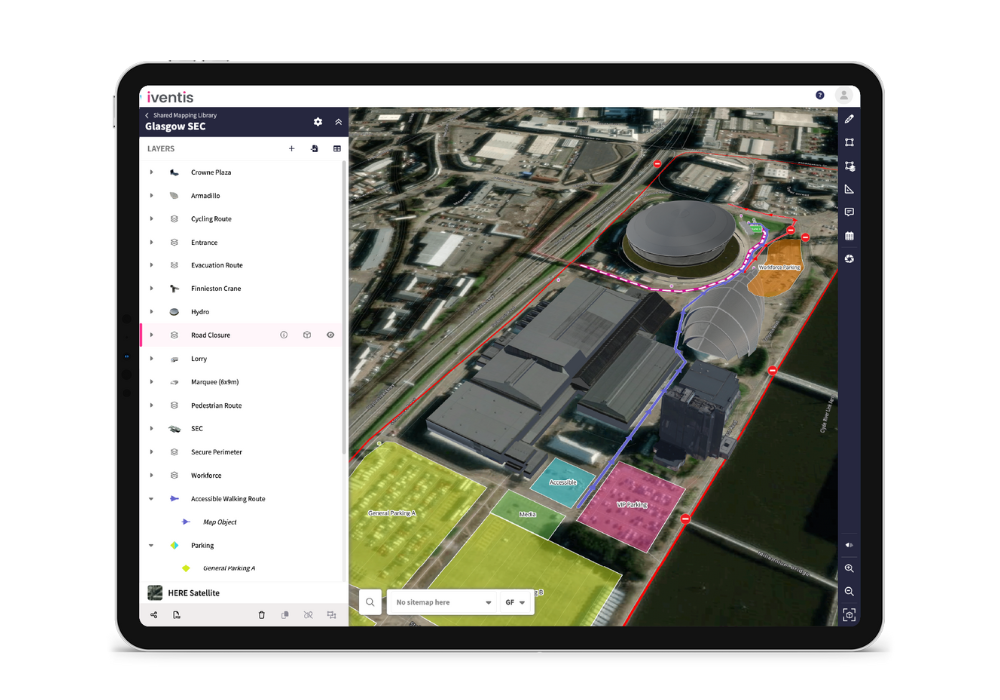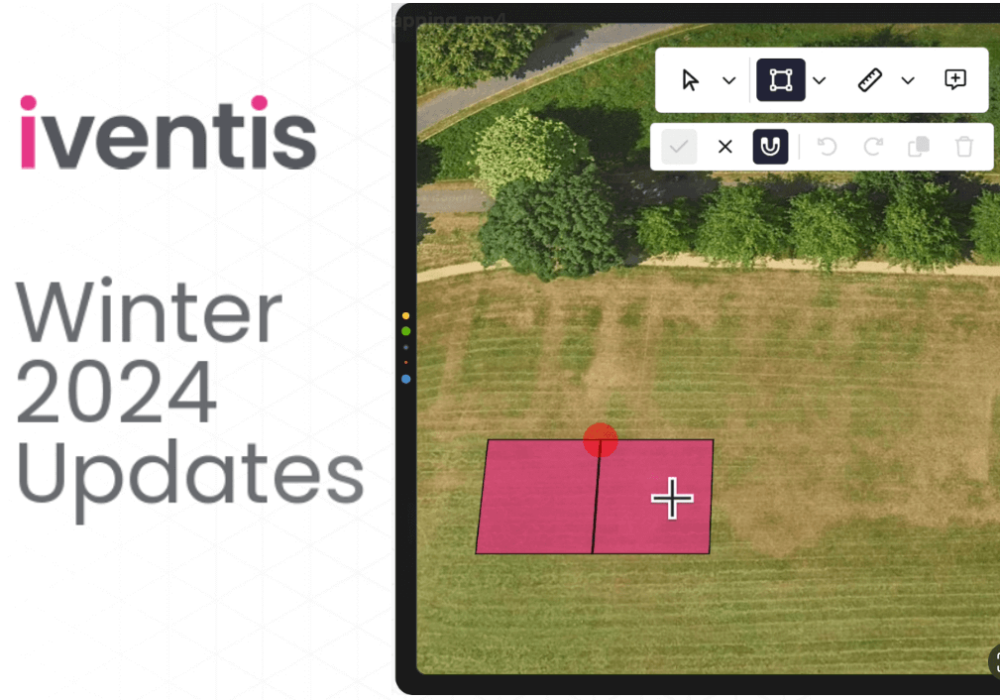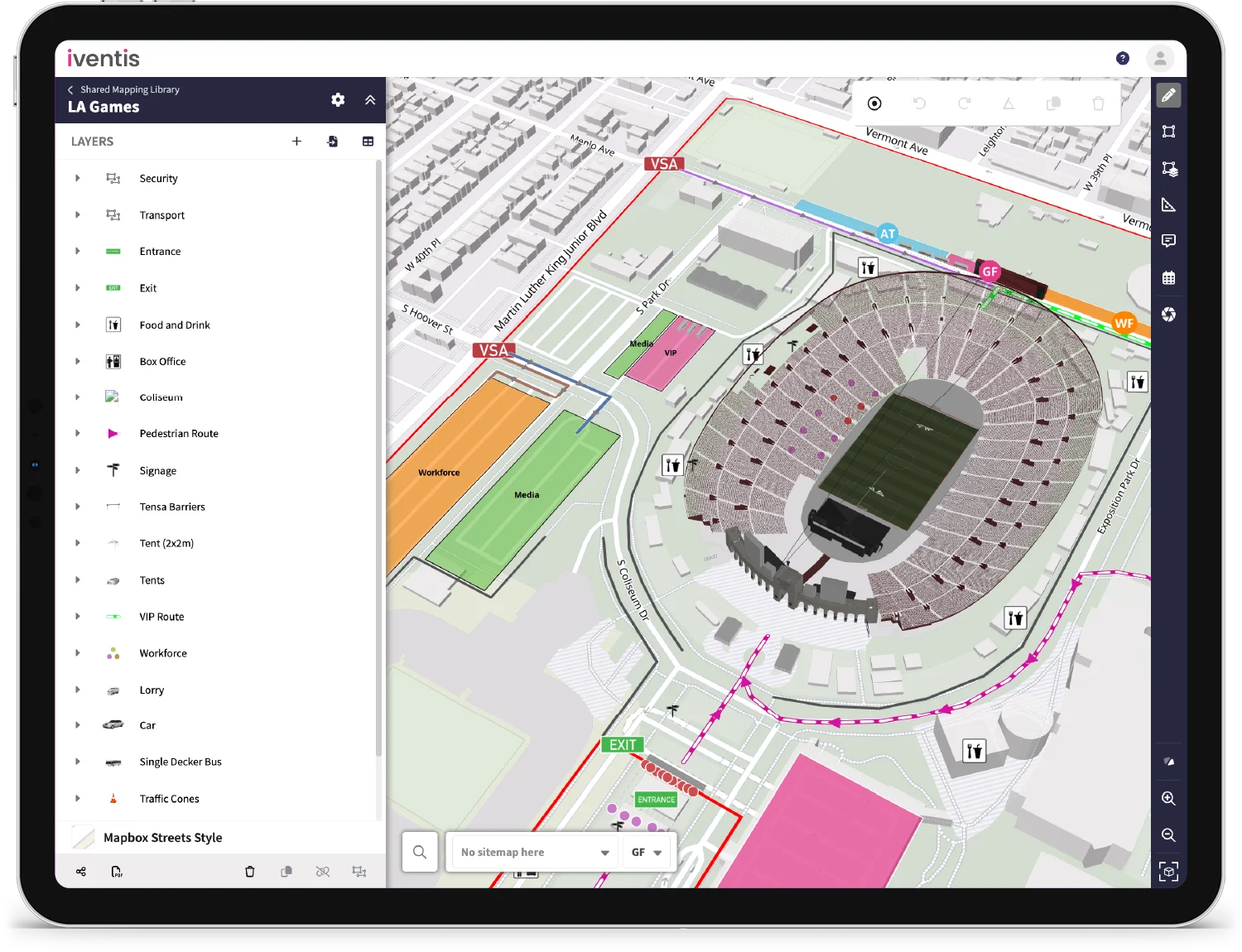After working on several major events, including the London 2012 Olympics and Baku 2015 European Games, I started Iventis because I felt the full potential of GIS Mapping software was not being realised. I believe it failed to meet the major requirement of large teams seeking to rapidly create, share and communicate their plans.”
During the years of preparation required to deliver a major event such as a World Cup or an Olympic Games, complex plans are constantly being produced and refined, covering everything from transportation to cleaning and waste.
A large and ever-growing team of planners must carefully co-ordinate their efforts between departments, as well as with a vast array of suppliers, stakeholders and participants.
Since operational plans are most effectively communicated visually through maps and drawings, GIS Mapping Software can be a powerful tool.
However, major event organisers have taken very different approaches when using this technology, and the scale and speed at which plans are developed presents unique challenges. Even if it is adopted by organisers, they may not have the time or resources to build the capability to take advantage of it.
This blog explores the experiences of Iventis CEO & Founder, Joe Cusdin, which led him to develop an alternative.
What is GIS?
Although awareness has been increasing, despite its potential applications in major event planning, GIS mapping software is not a widely well-known tool. In part, this is because it represents an entire field, so it is difficult to define.
In this context, its main purpose is to centrally gather and share geographic/spatial information. An example of this information could be the locations of venues and accommodation sites for an event as well as the transport services, such as bus routes, between them. This data is then made available either through online maps, or outputs such as PDF maps created using desktop GIS software and/or graphic design software.
As well as managing and sharing maps, GIS software also offers powerful analysis opportunities such as calculating the journey times between accommodation and venues.
Theoretically, it offers the ability to capture, manage, share and analyse complex plans and therefore greatly assist event organisers across almost every aspect of planning.
In reality, the approach and results vary significantly.
London 2012
Over the years, millions would have been spent on the people and software to communicate plans.
The London Olympic organisers fully embraced GIS mapping software from the bid stage and throughout the subsequent seven years of planning.
At its peak, there were perhaps 20 people working on this full time, mainly producing maps for public consultations, spectator and other client group information, or simply sharing information with stakeholders. Other key agencies, such as Transport for London, also had teams working on mapping. As plans were regularly changing, they had to be communicated widely, clearly and accurately. Over the years, millions would have been spent on the people and software to achieve this. For more details see this report.
The London 2012 Games required over 7,000 maps to be produced by the GIS team, and many more were created outside of GIS and mapping to communicate plans.
The approach was pioneering at the time, with a centralised, comprehensive and diligently controlled spatial database to manage information. Online GIS mapping was in its infancy (ArcGIS online only launched officially in June 2012) and while the team explored this new technology and recognised its potential, the only option was to have a team of GIS specialists and cartographers managing and producing content.
The process of getting the right information from the right people at the right time, then finally into the right format, was lengthy and time consuming. While the GIS team had the skills and software to perform the task, they didn’t know the details of the operational plans – and those who knew the plans couldn’t use, or didn’t have access to the software. To create a map, the GIS specialists had to become experts in the plans of whatever they were representing.
As a result, the mapping process involved collecting plans that were sketched on paper, translating that data into the GIS database and eventually outputting map products. That was just the tip of the iceberg, as those providing the information also had a complex task of pulling plans from various sources, and deciding what could/should be shared. With so many people involved, working out which version was ‘correct’ was not always straightforward. This would almost always be a long and iterative process, with some back and forth required to understand sketched detail and review the GIS team’s work.
London’s approach was thorough, but required significant people, software and resources to work. Because web-based platforms weren’t in wide use, it was the best which could be achieved at the time. Due to the lengthly process involved, by the time a map had been produced, it was likely already out of date. In the end, anything which needed to be produced quickly would often happen outside of GIS by whatever means available – usually PowerPoint slides or Visio.
Baku 2015 European Games
The 1st European Games was a major event held in Azerbaijan in 2015 involving almost 6,000 athletes from 50 countries competing in 30 sports.
After working on the London 2012 Olympics, Joe’s second experience of planning a major event was the Baku 2015 European Games. A team who mainly worked on the London Games were brought together to deliver this large-scale event in a relatively short time frame of about two years.
Hundreds of plans and thousands of iterations were drawn in PowerPoint, Visio, Word documents or hand drawn
The approach here was in stark contrast, with technology such as GIS mapping software much less widely adopted and very few people in the organisation who were familiar with it. With accelerated timescales the teams were left to their own devices to decide how to communicate their plans. Hundreds of plans and thousands of iterations were drawn in PowerPoint, Visio, Word documents or hand drawn. Sometimes they were created in CAD, taking up valuable time from CAD specialists.
When the requirement became apparent, the same GIS technology used in London was implemented, with the necessary consultancy support to manage it. The team was keen to make more of the web mapping technology which emerged just before the London Olympics, and try to put more control of the plans and data into the hands of the planners themselves to alleviate the bottlenecks and reduce the limited team’s workload.
It wasn’t long before issues with this approach became clear. The software was too difficult for most users to manage themselves and they had limited time to learn, so they were forced to feed information to the GIS consultants/cartographers, once again creating bottlenecks. If anyone needed a map quickly, GIS was not a viable option. The system became used exclusively for publications – where most of the work happened in Illustrator anyway. The costly GIS software itself was underutilised.
GIS Mapping Software was brought in mid-way through planning. Despite efforts to use it for operational planning, limitations restricted it’s use primarily to producing publications.
Due to these constraints, despite having GIS technology, the majority of spatial planning would still happen informally using whatever tools the team had access to.
Other Events and Approaches
GIS mapping software has been used on other events more recently with a similar pattern:
- Mapping/GIS systems are usually not considered or budgeted for until planning is well underway. This is either in response to issues faced controlling/producing spatial data, or more likely advocated by certain team members who have used it before. As a result, teams develop their own workarounds/methods to produce maps and visual outputs by any means available and the information is uncontrolled.
- Because GIS software is industry agnostic, it takes considerable time and resources to build a team then customise the software and processes to make it work to its full potential. Combined with the above point, and the relatively short lifespan of an event organising committee, it’s difficult to fully embed it into workflows and processes.
- When GIS is adopted, the typical approach is to tightly control the geographic database – with only a very limited number of users able to make changes. This is partly to maintain data integrity, but can also be due to technical or licensing limitations. Editing the data requires training in GIS or user-friendly apps to be purpose built which takes time and money.
- Access to GIS data is usually via an online/web viewer. For the vast majority of users, it is read-only, or only available on request.
- GIS has historically not integrated well with CAD, despite them both showing spatial plans. While this has improved, it’s still pretty challenging to combine detailed drawings with wider area mapping. Users therefore have to resort to PDF CAD outputs for detailed planning around venues.
- Professional or high-quality outputs need to be produced by cartographers/designers outside of GIS software to be visually clear and appealing. There are usually more outputs needed than they can cope with at the speed required, so teams must resort to other methods.
The result is always that the potential of GIS Mapping Software to transform planning is severely limited. After Baku, Joe set out to create a tool that would put control of plans into the hands of the planners themselves.
A New Approach with Iventis
Iventis is designed to be used by anyone in the team with minimal/no training and we deliberately avoid calling it ‘GIS’. It also solves the problem of CAD integration and can be made available immediately with recommended business processes in place. We avoid a ‘per user’ licensing model to ensure the information is shared amongst everyone who needs it.
On the largest projects, sometimes more specialist work is required. We regularly work in situations where a hybrid approach of more traditional GIS works alongside our system and is complimentary. The data can even feed into our system, such as existing Local Authority information. However, we remove the burden and pressure placed in what are often limited GIS resources.
Our visual event planning platform aims to be easy to use and accessible for wider teams. It has been used on several major events since 2017.
By opening the data there can be a trade-off with data integrity. Getting the right balance between open access and maintaining quality data is difficult, and tends to result in either completely open or closed approaches.
We have taken the lessons learnt over the past few years and are developing new approaches to provide rapid/easy access to update plans whilst maintaining data integrity. This will be achieved via an innovative data structure, comprehensive permission controls and built-in versioning.
Through our platform we aim to unlock the power of geo-spatial technology and bring its considerable benefits to a much wider set of users. With increasing pressure to deliver major events efficiently we believe unlocking this potential can be an essential tool to achieve that goal.





